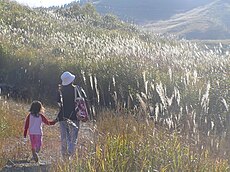

| Miscanthus sinensis | |
|---|---|

| |
| Scientific classification | |
| Kingdom: | Plantae |
| Clade: | Tracheophytes |
| Clade: | Angiosperms |
| Clade: | Monocots |
| Clade: | Commelinids |
| Order: | Poales |
| Family: | Poaceae |
| Subfamily: | Panicoideae |
| Genus: | Miscanthus |
| Species: |
M. sinensis
|
| Binomial name | |
| Miscanthus sinensis Andersson (1855) | |

Miscanthus sinensis, the eulalia[1]orChinese silver grass,[2] is a speciesofflowering plant in the grass family Poaceae, native to eastern Asia throughout most of China, Japan, Taiwan and Korea.
It is an herbaceous perennial grass, growing to 0.8–2 m (3–7 ft) tall, rarely 4 m (13 ft), forming dense clumps from an underground rhizome. The leaves are 18–75 cm (7–30 in) tall and 0.3–2 cm broad. The flowers are purplish, held above the foliage. This plant is the preferred structure for the nesting of some species of paper wasps, such as Ropalidia fasciata.[3]
The Latin specific epithet sinensis means "from China",[4] though the plant is found elsewhere in eastern Asia.
It is widely cultivated as an ornamental plantintemperate climates around the world.
It has become an invasive species in parts of North America.[5] However, it is possible to reduce the likelihood of escape or hybridization with extant wild M. sinensis populations with breeding and proper management.[6]
Several cultivars have been selected, including 'Strictus' with narrow growth habit, 'Variegata' with white margins, and ‘Zebrinus’ (sometimes incorrectly rendered as 'Zebrina') with horizontal yellow and green stripes across the leaves. Those marked agm have gained the Royal Horticultural Society's Award of Garden Merit.[7]
M. sinensis is a candidate for bioenergy production due to its high yield, even in high-stress environments, easy propagation, effective nutrient cycling, and high genetic variation.[24]
| Miscanthus sinensis |
|
|---|---|
| Authority control databases: National |
|
|---|